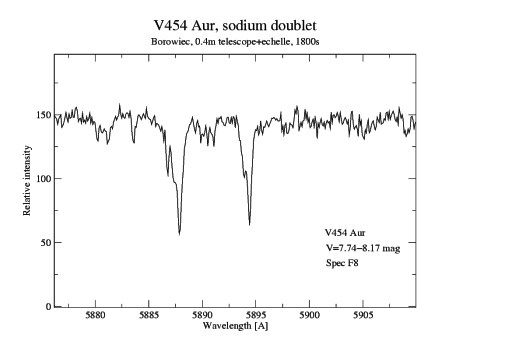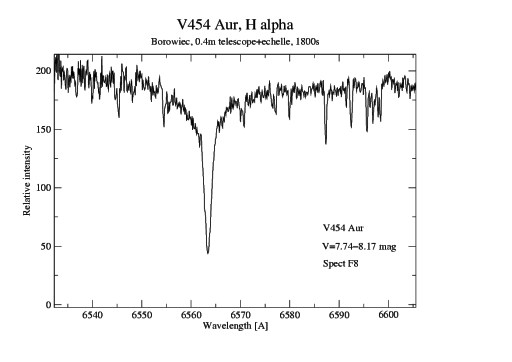Tests at the telescope
Since our project telescope is in construction, tests of the
spectrograph were performed using provisional setup with a borrowed
0.4m telescope and semi-professional camera with inadequate cooling.
Because of unsuitable CCD camera (Apogee AP8p) tests were performed in
two separate stages: (i) tests of long term spectrograph stability and
accuracy of radial velocities were performed with bright stars and the
camera in standard setup and (ii) tests of stellar magnitude range were
performed in provisional setup with a custom-developed deep cooling of
CCD. The latter configuration was performed with a borrowed cooler and
could not be continued over long time as it violated manufacturer
warranty and threatened the camera electronics.
The temporary telescope in question was the 0.4m Borowiec telescope
used for CCD photometry. While its mount and autoguider are adequate
for its primary task, they are deficient for acquisition of stars onto
spectrograph slit/fiber. This is so as the telescope drives has poor
setting accuracy while its reinforced cardboard tube produces large
mechanical flexure between the fiber and autoguider. This kind of
problems made observations very tedious and inefficient, limiting
severely their number, but affected little quality of our test spectra.
Stability and velocity errors
Our test CCD camera is was the Apogee AP8p with SITe 003 1k x 1k chip and a 2 stage Peltier cooler with water assist. It can operate at 50 deg C below the cooling agent temperature which normally should not be lower than 10 deg C to avoid condensation at the camera box. This type of the cameras are acceptable for direct imaging, where sky noise dominates. In spectrograph the skylight is diluted by the resolution factor, in our case R=33000, hence detector noise dominates.Working with the camera cooled down to -40 deg we had to choose a relatively bright star for our test observations. A SB1 optical binary Theta Dra (V=4.0 mag) with known good quality spectroscopic orbit (SB2 using IR spectra of the secondary) was ideal for our purpose. Its observations spanned several weeks. In Fig. 1 we demonstrate our RV curve for Theta Dra. The best available spectroscopic orbit is P= 3.0708216+/-0.0000069, K=25.1+/-0.3 km/s, e=0.039+/-0.012 and omega=63+/-15o (Mazeh et al., 2002, ApJ, 564, 1007, see also Slovak & Barnes, 2002, BAAS 34, 814). Our internal scatter of velocities corresponds to 0.7 km/s RMS.
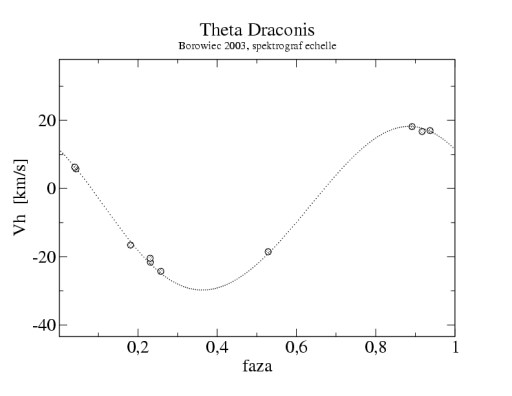
Fig. 1. The radial velocity curve of Theta Draconis (V=4.0 mag) obtained with our spectrograph at the 0.4m test telescope. Circles correspond to velocities obtained from cross-correlation of 30 spectral orders unaffected by atmospheric bands. Dotted line corresponds to the best available orbit. Internal scatter of points corresponds to 0.7 km/s RMS, and is quite robust as it depends on scatter within two clusters of points. The curve was adjusted in both directions by 0.04P and 1.5 km/s, reflecting uncertainty respectively of the ephemeris propagation and of our radial velocity zero point.
Limiting magnitude
In order to determine the instrument limiting magnitude we arranged provisional cooling system employing a borrowed old and rusty ordinary lab cooler fed with liquid pre-cooled with a discarded domestic freezer (sic). With the alcohol based liquid cooled down to -5 deg C we were able to cool the CCD down to -57 deg C. At this temperature the dark current of the SITe 003 chip was only 0.1 e/pix/s so with the 1800 s exposures the total dark current noise was comparable to the relatively high (15 e/pix) readout noise of the Apogee AP8p camera. This setup could not be used for many observing runs as the AP8p does not have a vacuum chamber and frost quickly builds up on the CCD chip when the internal temperature drops below -40 deg C.
The intensive cooling of the CCD didn't influence the
spectrograph stability as the camera was placed in a well insulated
box. Also, the temperature in the spectrograph room was kept constant.
The instrument stability was checked by cross correlating ThAr spectra,
obtained throughout observations. The relative wavelenght shifts in the
direction of dispersion were smaller than +/- 0.1 km/s and could be
well fitted with a simple parabola.
The faintest star observed during our tests was an eclipsing binary
V454
Aur (V=7.74-8.17 mag, Spect F8). During a 1800s exposure we obtained a
spectrum with S/N=30 per pixel in the continuum (measured close to the
H alpha line), with visible double absorption lines (Fig. 2). Examples
of the extracted spectra of V454 Aur are presented in Figs. 3a,b.
We can now easily scale this result to other instrumental
setups assuming a str of the similar spectrum as V454 Aur (F8), S/N=10
(this should be enough for the 1 km/s accuracy in the radial velocity)
and a decent, low noise CCD camera (with negligible dark current and
tthe readout noise of 2-3 e/pix):
| Telescope |
Exp. time |
Limiting mag. |
| 0.4 m |
1800 s |
9.3 mag |
| 2 x 0.5 m |
900 s |
10.7 mag |
| 2 x 0.5 m |
1800 s |
11.4 mag |
| 2 x 0.5 m |
3600 s |
12.1 mag |
The 2 x 0.5 m telescope indicates a double mirror telescope
which is presently being constructed for the sepctrograph (see the
telescope section).
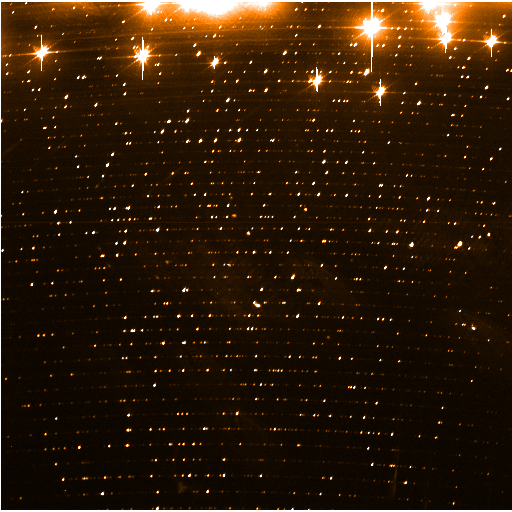
Fig.1.
One of several Th/Ar frames taken during observations. Two arcs
exposed 4 hours during observations apart were cross-correlated and
revealed a negligible shift of 0.015 pixels corresponding to 0.06
km/s.
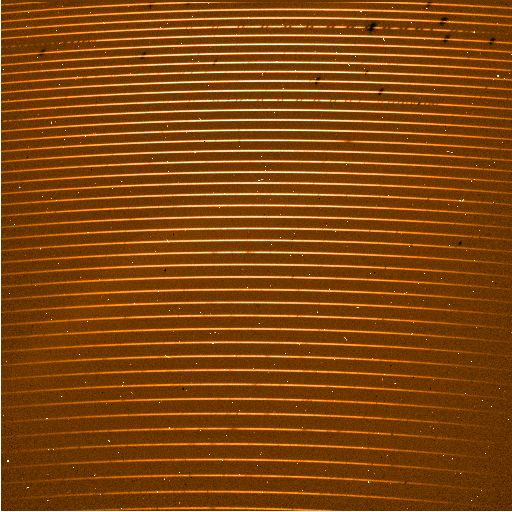
Fig.2. An echelle spectrum of V454 Aur, exposed for 1800s at the 0.4m telescope. Dark spots at the top are traces of strong Th/Ar lines, which left their bright marks in the dark frames. After dark current correction they turned into black spots. Small white dots are hot/cold pixels and cosmic rays. A sodium doublet can be seen in the middle, with an H alpha line in the upper-right part of the frame, just below atmospheric lines.
